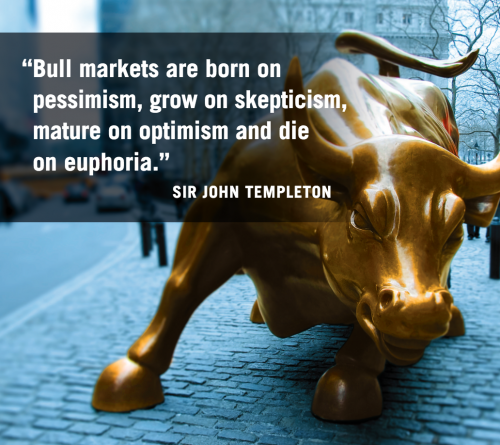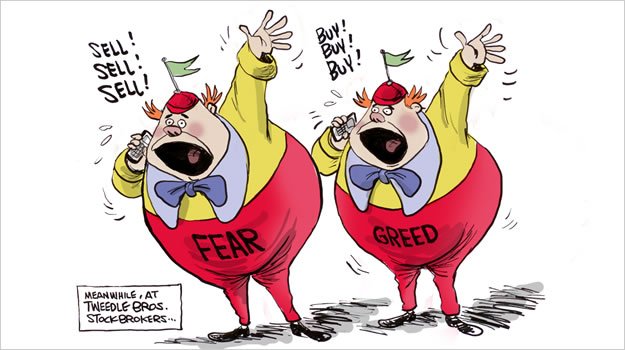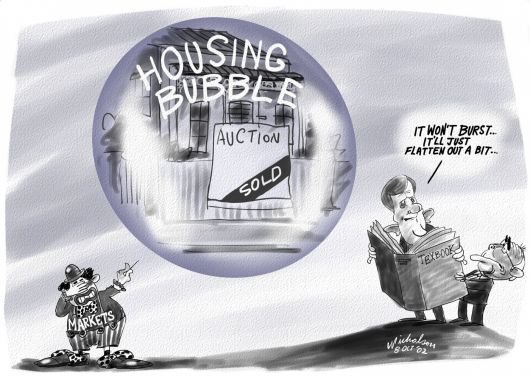John Templeton, Market Cycles and The Value of STEEM
Legendary investor, businessman and poker aficionado John Templeton famously said…
"Bull markets are born on pessimism, grow on skepticism, mature on optimism and die on euphoria."

Templeton died in 2008 at the age of 95. Having become one of the wealthiest investors in the world, throughout his life he gave away over $1 billion to charitable causes. There is much we can learn from a man who has given away more money than most people ever dream of making.
Templeton was the classic contrarian investor. He believed the only way to profit as an investor was to buy when everyone else was selling, and sell when everyone else was buying. Here’s another one of his quotes:
"The time of maximum pessimism is the best time to buy, and the time of maximum optimism is the best time to sell."
When World War II began and everyone in the financial markets panicked, he bought shares in every listed company that was trading for less than $1. He ended up being successful on nearly every one of those trades.

Before it was a common strategy, he began investing internationally in distressed markets. Always in search of pessimism, buying outside the United States became his flagship approach. It paid off handsomely in the end. A $10,000 investment in his emerging markets fund in 1954 would have net $2 million by the end of Templeton’s career in the early 1990’s.
Then he shorted technology stocks just before the March 2000 NASDAQ crash and made $86 million. When everyone was bullish and buying, he foresaw the carnage to come.
3 Lessons From Templeton’s “Bull Markets” Quote

Templeton’s quote about bull markets perfectly sums up his strategy. Here are three things we can learn:
1. All financial markets go through cycles.
According to Templeton, every market goes through a life cycle, similar to the natural life of living beings. Markets are born, they grow, they mature, and then they die. Eventually, another one is born and the process repeats itself.

The Austrian economists have been the major proponents of business cycle theory. They claim that low interest rates tend to stimulate excessive borrowing from the banking system. This then leads to an increase in capital investment and a “boom” in asset values. An inevitable correction or “bust” occurs when credit is no longer available.
We can apply this same theory to financial markets. Whether the asset class is shares, real estate, bonds, or even crypto, all assets tend to go through cycles. In some years there is significant growth, in other years prices are flat, and in some years values fall.
Here are the four stages of the asset price cycle:
- The Value Stage
The value stage represents the birth of the market. Assets are inexpensive relative to incomes or earnings, and most investors tend to be pessimistic about the potential for increases in the price of the asset. Many may have even been burned in previous bad deals or trades.
Credit tends to be tight in this phase. Investors struggle to get loans to leverage their potential returns. People tend to be keenly aware of the dangers of excessive debt, mainly because they’ve recently experienced financial turmoil.
- The Growth Stage
In the growth stage, the market begins to rise. The growth is slow in the beginning, but over time momentum increases. Investors remain somewhat skeptical about the asset as an investment, but the tide of opinion gradually turns as prices continue to rise and credit loosens.
With real estate, the most desirable areas or economically strong cities experience growth first, and then demand ripples outward to surrounding areas. With the stock market, many investors are still reeling from the pain of the previous bust, but gradually become less skeptical.
- The Boom Stage
The boom stage is the lead up to the peak of the market. This is a period of rapid growth and is marked by significant investor confidence. With real estate, some areas may grow as much as 20 or 30 percent in a year. In the stock market, share prices begin to inflate beyond what seems rational based on earnings.
Many first-time investors jump on the bandwagon in this phase. In fear of missing out or getting shut out of the market, they naively assume that values will continue to rise indefinitely. Even amongst seasoned investors, there can be rampant speculation. Investing becomes a common topic at dinner parties and social gatherings.
- The Bust Stage

The bust stage represents the death of the market. A sharp correction in values quickly turns investor euphoria into a somber lesson in the fundamentals of economics.
Sometimes this inevitable death can be delayed as central banks and governments keep the market on life support through low interest rates and stimulus. Rather than experiencing a bust, the market may retreat to a value stage again, and get a second or third chance at life. But eventually, death will come. It is unavoidable.
2. Market cycles are fueled by investor emotion.
The second thing Templeton’s quote teaches us is that the market grows in response to emotional or psychological factors, like fear and greed. While fundamental influences, such as supply and demand and the availability of cheap credit underpin human emotion, it’s the psychological factors that accentuate the market's boom and bust.

In a desire to acquire as much wealth as possible in the shortest amount of time, investors begin to act irrationally. They ignore fundamental trends of value and affordability, and go all-in.
Conversely, once investors begin to sniff danger in the market, they rush, often all at once, for the exit. The biggest losers are the ones left holding their assets when the party’s over.
3. The majority of investors are always one step behind the cycle.
Finally, here’s the most important lesson for us from Templeton. While there are some investors who understand the fundamental drivers of the market, and can discern it’s current stage in the life cycle, seeing things that others cannot see, the masses tend to be one step behind.
Even after the market has been reborn and is growing, most investors tend to remain pessimistic and skeptical. Fear prevents them from entering the market at the most opportune time.
As the market approaches its peak, more and more investors optimistically jump on board. Eventually euphoria sets in. According to Templeton, this point marks the death of the market. The “greatest fool” is left holding overpriced assets.
The Greater Fool Theory
The greater fool theory, which I’ve already written briefly about here, states that the price of an asset is ultimately determined, not by market fundamentals, but by irrational beliefs and expectations of investors. They buy under the assumption that the asset can always be sold in the future to a “greater fool,” someone willing to pay a higher price.
The boom is over when the greatest fool buys. Once the greatest fool buys, the bust is imminent. It’s anyone’s guess when the greatest fool will buy, but what’s important is to make sure that you’re not the greatest fool.
The Fools in Australia’s Real Estate Market

In my day job, I mentor Australian property investors. One of my biggest challenges is to help people break out of the common Aussie mindset that all real estate always goes up in value.
It’s been 25 years since Australia has seen a recession. Even in 2008, the government here borrowed to literally deposit money into people’s bank accounts, the reserve bank slashed interest rates, and property prices never corrected. In fact, they’ve continued to rise, especially in Sydney and Melbourne over the past three years.
Investors continue to speculate on rising prices even in Sydney, where the home price to income ratio is over 12 to one. I recently heard about a two-bedroom apartment near Bondi Beach that sold for $2 million. Five years ago, the same property was worth $1 million. There are hundreds of these stories every week.
It sure seems Australian real estate is approaching maximum optimism. Soon the greatest fool will buy, and that will mark the end of the cycle.
The Price and Life-Cycle of STEEM

At the other end of the spectrum is STEEM specifically, and crypto in general. People tend to be pessimistic about it, either because they don’t understand it or because they’ve never even heard of it. Even crypto-loyalists are labeling STEEM a scam and ridiculing the founders. These are all very normal psychological responses to the fact that STEEM is now in the beginning of its value stage.
How would you apply Templeton’s quote to crypto in general and STEEM specifically?
Is a bull market in STEEM being born?
Do you see the general sense of pessimism as a sign of a buying opportunity?
Please take a moment to leave a comment and let me know.
Thanks for posting. I've been thinking for a few years that the real estate market in Aus should crash soon, but it still doesn't seem to be slowing. Cheap credit is still reasonably plentiful, interest rates are low... the dream can't last forever though.
With Steemit, the price of Steem rose to the high of $4 and everyone was excited, and then naturally drifted back down. I thought it would do something like that, because naturally that's what happens after spikes, but many people seemed to be a little unprepared, and a few people were wondering if it spelt the end. Now it seems to be stabilising and I guess it's in a new value phase. Still early days though, so who knows.
As far as Aussie real estate goes, it's quite an amazing phenomenon. It's a combination of the mining boom, China's money creation flowing in, growth in immigration, concentration of jobs around five key capital cities, urban planning restrictions, generous tax concessions for investors, and above all, the availability of cheap credit. It really has been the perfect storm.
The market should have corrected in 2008 when credit contracted, but only flattened out because of government stimulus and the RBA slashing interest rates. The RBA cash rate is 1.5% (lowest in history) and still could go lower, so unless/until there's another credit crisis overseas, who knows how high property prices here can go. I do believe regulators will step in and try to direct credit away from Sydney and Melbourne housing. There are beginning to be some class warfare grumblings.
Regarding STEEM, I agree. There was a mini boom and bust but hopefully on the way to a true growth phase. Who knows, perhaps without central bank intervention, we might see a sustainable currency established. Time will tell.
Appreciate your comment.
Right, I saw a bit of nonsense stirring up on my Facebook feed about negative gearing. Everyone talks about negative gearing, but nobody talks about central banking... it's quite bizarre. I don't know how I've been so lucky to stumble into this information, watching Zeitgeist or whatever, while so many people are just willing to believe what Walid on the TV tells them
It would blow your mind the conversations I have with people who are convinced that the Aussie real estate market is untouchable. It will be a rude awakening some day.
You would think that after watching the American real estate market crash, people would believe it's not only possible, but also probable.
Thanks for writing this. Really great analysis of the psychology of investing and how we fool ourselves into imagining easy profits with little to no risk, at times.
Many people in the world would do well to learn about these principles. Upvoted/ followed.
Take care. Peace.
Many thanks @krnel. Looking forward to connecting more.
excellent post @jasonstaggers
This should be read by all that "predict" market crashes. they keep saying it and when it comes they appear prophets. how very convenient.
Thanks @kyriacos. Good point. If you understand some basics of economics, "predicting" the future becomes relatively straight forward.
Good article. I am a bit of a contrarian so I mostly agree.
Thanks @gamgam. Do you have much history with crypto? Where do you see Bitcoin in its life cycle?
I'm not really crypto savy enough to add much of a discussion comment, but I did enjoy your article, and learned alot from it. I could easily see the similarities in Templeton's examples with that of different situations within Steemit before you mentioned it, and for someone not in the know, such as myself, I was still able to understand as well as deduce some good tips. Thanks for the well done article!
Thanks @mahma. Appreciate you taking the time to comment. Glad it was helpful :)
The pleasure was all mine. :)
Very nice, just how I called the Monero investment. I rarely buy into a Bull market, and I saw it before it gone up massively. Now I made 249% profit, and have already cashed out. It is a form of art to spot them.
That's awesome, well done! I've heard Austrian economists refer to them as entrepreneurial investors. They have an uncanny ability to see what other market players can not. It is a valuable gift.
Well I just did my homework. Due diligence and a good source of news can always come in handy, not to mention with good market analysis skills.
Monero, Steem, Synereo, Factom ETC
This post has been linked to from another place on Steem.
Learn more about linkback bot v0.3
Upvote if you want the bot to continue posting linkbacks for your posts. Flag if otherwise. Built by @ontofractal